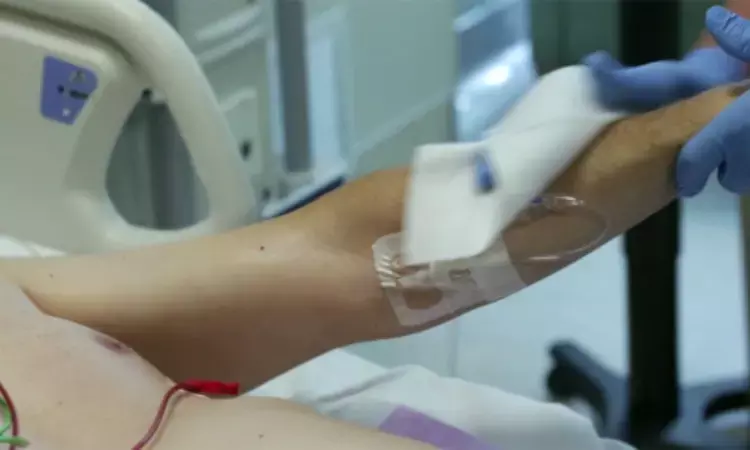- Home
- Medical news & Guidelines
- Anesthesiology
- Cardiology and CTVS
- Critical Care
- Dentistry
- Dermatology
- Diabetes and Endocrinology
- ENT
- Gastroenterology
- Medicine
- Nephrology
- Neurology
- Obstretics-Gynaecology
- Oncology
- Ophthalmology
- Orthopaedics
- Pediatrics-Neonatology
- Psychiatry
- Pulmonology
- Radiology
- Surgery
- Urology
- Laboratory Medicine
- Diet
- Nursing
- Paramedical
- Physiotherapy
- Health news
- Fact Check
- Bone Health Fact Check
- Brain Health Fact Check
- Cancer Related Fact Check
- Child Care Fact Check
- Dental and oral health fact check
- Diabetes and metabolic health fact check
- Diet and Nutrition Fact Check
- Eye and ENT Care Fact Check
- Fitness fact check
- Gut health fact check
- Heart health fact check
- Kidney health fact check
- Medical education fact check
- Men's health fact check
- Respiratory fact check
- Skin and hair care fact check
- Vaccine and Immunization fact check
- Women's health fact check
- AYUSH
- State News
- Andaman and Nicobar Islands
- Andhra Pradesh
- Arunachal Pradesh
- Assam
- Bihar
- Chandigarh
- Chattisgarh
- Dadra and Nagar Haveli
- Daman and Diu
- Delhi
- Goa
- Gujarat
- Haryana
- Himachal Pradesh
- Jammu & Kashmir
- Jharkhand
- Karnataka
- Kerala
- Ladakh
- Lakshadweep
- Madhya Pradesh
- Maharashtra
- Manipur
- Meghalaya
- Mizoram
- Nagaland
- Odisha
- Puducherry
- Punjab
- Rajasthan
- Sikkim
- Tamil Nadu
- Telangana
- Tripura
- Uttar Pradesh
- Uttrakhand
- West Bengal
- Medical Education
- Industry
Nasal Mupirocin tops nasal Iodophor antiseptic in setting of CHG bathing in ICU patients: JAMA

USA: Universal mupirocin-chlorhexidine gluconate (CHG) bathing is superior to universal iodophor-CHG for reducing S aureus and MRSA clinical cultures in critically ill patients, claims a large-scale, pragmatic trial. The findings were published in the Journal of the American Medical Association (JAMA) on October 10, 2023.
Universal nasal mupirocin with CHG bathing prevents all-cause bloodstream infections and methicillin-resistant Staphylococcus aureus (MRSA) infections in intensive care units (ICUs). Antibiotic resistance to mupirocin has raised questions about the advantages of an antiseptic for ICU decolonization.
In the noninferiority, cluster randomized trial of 801 668 admissions at 137 hospitals, the researchers revealed that exposure to nasal mupirocin significantly reduced S aureus clinical cultures by 18.4% versus iodophor in adult ICUs in the context of daily chlorhexidine bathing.
The study was conducted by Susan S. Huang, University of California Irvine School of Medicine, Irvine, and colleagues to compare the effectiveness of iodophor versus mupirocin for universal ICU nasal decolonization in combination with CHG bathing.
For this purpose, the researchers conducted a two-group noninferiority, pragmatic, cluster-randomized trial in US community hospitals all of which used mupirocin-CHG for universal decolonization in ICUs at baseline. It included adult ICU patients in 137 randomized hospitals during baseline (2015 to 2017) and intervention (2017 to 2019). Among the 801 668 admissions in 233 ICUs, the mean of the participants was 63.4 years, and the mean ICU length of stay was 4.8 days.
Universal decolonization involved switching to iodophor-CHG (intervention) or continuing mupirocin-CHG (baseline).
Proportional hazard models were used to evaluate ICU-attributable S aureus clinical cultures (primary outcome), all-cause bloodstream infections, and MRSA clinical cultures to find out differences from baseline to intervention periods between the strategies. In the same hospital network, a comparison of the results was done with a 2009-2011 trial of mupirocin-CHG versus no decolonization. The prespecified noninferiority margin for the primary outcome was 10%.
The researchers reported the following findings:
- Hazard ratios (HRs) for S aureus clinical isolates in the intervention vs baseline periods were 1.17 for iodophor-CHG (raw rate: 5.0 vs 4.3/1000 ICU-attributable days) and 0.99 for mupirocin-CHG (raw rate: 4.1 vs 4.0/1000 ICU-attributable days) (HR difference in differences significantly lower by 18.4% for mupirocin-CHG).
- For MRSA clinical cultures, HRs were 1.13 for iodophor-CHG (raw rate: 2.3 vs 2.1/1000 ICU-attributable days) and 0.99 for mupirocin-CHG (raw rate: 2.0 vs 2.0/1000 ICU-attributable days) (HR difference in differences significantly lower by 14.1% for mupirocin-CHG).
- For all-pathogen bloodstream infections, HRs were 1.00 (2.7 vs 2.7/1000) for iodophor-CHG and 1.01 (2.6 vs 2.6/1000) for mupirocin-CHG (nonsignificant HR difference in differences, −0.9%).
- Compared with the 2009-2011 trial, the 30-day relative reduction in hazards in the mupirocin-CHG group relative to no decolonization (2009-2011 trial) was as follows: S aureus clinical cultures (current trial: 48.1%; 2009-2011 trial: 58.8%) and bloodstream infection rates (current trial: 70.4%; 2009-2011 trial: 60.1%).
"Nasal iodophor antiseptic failed to meet criteria to be considered noninferior to nasal mupirocin antibiotic for the outcome of S aureus clinical cultures in adult patients admitted to ICU in the context of daily CHG bathing," the researchers wrote. "In addition, the results were consistent with nasal iodophor being inferior to nasal mupirocin."
Reference:
Huang SS, Septimus EJ, Kleinman K, et al. Nasal Iodophor Antiseptic vs Nasal Mupirocin Antibiotic in the Setting of Chlorhexidine Bathing to Prevent Infections in Adult ICUs: A Randomized Clinical Trial. JAMA. 2023;330(14):1337–1347. doi:10.1001/jama.2023.17219
Dr Kamal Kant Kohli-MBBS, DTCD- a chest specialist with more than 30 years of practice and a flair for writing clinical articles, Dr Kamal Kant Kohli joined Medical Dialogues as a Chief Editor of Medical News. Besides writing articles, as an editor, he proofreads and verifies all the medical content published on Medical Dialogues including those coming from journals, studies,medical conferences,guidelines etc. Email: drkohli@medicaldialogues.in. Contact no. 011-43720751


